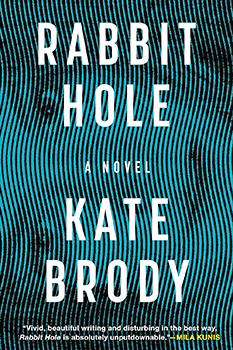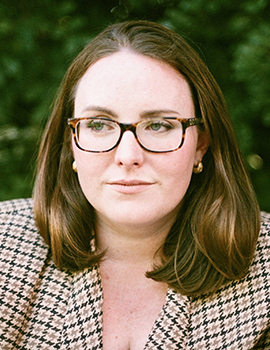

Features BookTrib Spotlight: Kate Brody
Crime Made Her Life a Spectacle. Then It Got Worse.
A Spotlight on Author Kate Brody
By Neil Nyren
 “I had always thought of my memory as something like a historical record. Evidence.
“I had always thought of my memory as something like a historical record. Evidence.
“Now, I’m not so sure. Now, I have a new appreciation for the unreliable narrator. Now, I understand how a normal person could go mad. It takes one tug at one thread, and the whole illusion vanishes.”
And when the illusion is gone, what remains?
In Kate Brody’s RABBIT HOLE, Theodora “Teddy” Angstrom has had more than her share of tragedy. First, her troubled 18-year-old sister Angie disappears, never to be heard of again. Then, 10 years to the day later, her father kills himself, driving through the wall of a covered bridge into the water below.
His desk is a rat’s nest of notes, Post-Its, and unpaid bills, and desperate to understand what happened, Teddy starts plowing through them.
Angie’s disappearance was a media sensation; her family was besieged by private investigators, tabloid reporters, religious mom groups, girls who went on TV and claimed to know Angie, and message board freaks spinning elaborate conspiracy theories. To her dismay, Teddy discovers that her father was one of the latter and, to discover the truth decides she has no alternative but to dive down the same rabbit hole that swallowed him up.
What she finds there, however, is nothing like what she could have imagined. Everyone around her was hiding secrets—her father, mother, sister—and the new people she meets as she follows her father’s trail are no different. Some of them will become friends, including the enigmatic Mickey, a near-double of Angie, who’s been obsessed with the case since fifth grade. Some will become lovers. Some will betray her. But it’s getting harder and harder to tell which is which.
The only thing Teddy can be sure of is that no one is telling her the truth. And if she can’t sort it all out soon, she may be the next tragedy for everyone to wonder about.
Full of twists and surprises, genuine mystery, and startling psychological portraits, RABBIT HOLE is a profound exploration into the nature of grief and identity. It is also an unsettling investigation into the shadowy line that separates the real world from the digital.
Because, sometimes, there’s no line at all.
“I wrote a novel in grad school that I would characterize as an MFA novel,” Brody says. “It didn’t have much plot; it just sort of meandered. For this book, I challenged myself to start with action. Force myself into a plot. So, the opening scene, with Teddy’s father, Mark, driving himself off a bridge—was always the first image. From there, I knew I wanted to incorporate gothic tropes—a decaying old house, a doppelganger, a sense of paranoia and madness. I was teaching British and American literature to high school students at the time, and I wanted to bring in elements of my favorite classics. The character of Mickey was born out of wanting to create an uncanny double of Teddy’s missing sister, Angie.
“The final piece was really the Reddit component. I am anthropologically interested in the way people communicate online and the way digital communities act on the ‘real world.’ Reddit was not a part of my life until I started writing this book, and then, over time, I became a Redditor in earnest. It’s very addictive.
“I wanted to make sure, with the Reddit sections, that I was capturing the cacophony of voices that come to life on the Internet. Early on in the book, Teddy finds a subreddit about her sister, and she discovers that strangers have been talking not only about Angie but about her. I wanted to make sure that experience rang true to the experience of so many women who have been objectified and sexualized by faceless, anonymous strangers.
“Angie’s case is not inspired by any one real-life disappearance. If anything, she is a stand-in for a certain type of missing girl who generates a lot of media attention. She’s young, white, and from a well-known family. How the public sees her—as a blank innocent—is because of those demographics, and it contrasts with how her sister knows her—as a rage-filled burnout. More than any one case, I was inspired by the true crime ecosystem—how it functions to both aid and torment families.
“The Angstroms would have, at one point, benefitted from Angie’s status among true crime obsessives. It would have provided them resources, like media and police attention. But by the time the book opens, the outside interest in Angie has curdled into something more sinister. She has become completely depersonalized. She is an object. The whole family has become fodder for the entertainment of strangers rather than victims of a tragedy. That trajectory, which I think we see with a lot of true crime fandoms, was the inspiration for much of the story.”
The characters were an inspiration as well, sometimes a very personal one:
“Teddy is perhaps an alternate version of me. A darker version. I think of this book as my grief book. It is an attempt to look at unresolved grief, how it can obscure a person’s identity and corrode their relationships. Teddy has never allowed herself to move on from what happened to her sister, and as a result, she is stunted at the age she was when Angie went missing. Because she is stuck in this holding pattern, barely scraping by, she starts to spiral as soon as her dad dies. She’s too brittle. She can’t cope with any more pain.
“When my own father was terminally ill, he wrote me some letters and one of them said, ‘Don’t be sad when the acute pain of sorrow grows gratefully more distant. Be glad that life goes on.’ I come back to that a lot. It’s weirdly easy to become comforted by your own pain. To almost fetishize it. But you can’t live in that space. Teddy is the version of me that really wanted to live there.
“I feel a bit further from Mickey. She’s bolder than I am, for one. I do relate to her need for intimacy and family. She carries the tough, rejected child version of herself around. She goes about things in a strange way, but at her core, Mickey’s looking for closeness and struggling to find it. I was a little like Mickey at 18, 19. A little intense, a little selfish, a little embarrassing.”
The writing process itself was pretty intense:
“After I finish something, I struggle to remember how I wrote it. I know certain scenes came to me nearly complete. Those tended to be scenes that were either high in conflict (I’m thinking specifically of a group dinner scene) or highly introspective. They become the tentpoles for the rest of the book. I don’t always write in order, but I have some sense of the trajectory of the story. That said, my first drafts are long and shaggy, and they often surprise me. At one point, I had it in my head that this was going to be a road trip book, and things obviously went in a different direction. With later drafts, I do a lot of structural edits to re-shape the plot. That is the real work of editing. The fun part is the sonic part. I love reading aloud and fixing sentences by moving words around. There’s nothing better than hearing the words click into the right order.
“Similarly, getting an image to feel fresh and new is so satisfying, especially if it’s related to the body. I am obsessed with the body, and I like thinking really deeply about how something feels or tastes or smells and then describing it as honestly as I can. The most challenging part of writing this novel for me was building the tension and suspense in editing because it can be hard to tell when you know the story so well as the writer if you’re succeeding. I can see all the turns and all the seams, so that part feels more like drudgery.”
It all paid off, however—even though the path from manuscript to book was hardly smooth:
“It was an odyssey! I queried the book during the pandemic. I had an infant, and I was teaching on Zoom from home. Everything felt very now or never. I was so, so lucky that the brilliant Hillary Jacobson responded quickly to the work. I got a couple offers of representation, but I knew she was the right person for RABBIT HOLE because of her editorial vision.
“Hillary and I worked on the book together for about ten months, and she connected me with Emma Finn in the UK, as well. Emma sold the book to Allegra le Fanu at Bloomsbury, and then Allegra and I worked together on edits for another ten months. (Allegra is the one who really pushed RABBIT HOLE to embrace its thriller status). While I was in the hospital in labor with my second son (a whole different odyssey), we received offers from American publishers. I feel very lucky that we ended up with Soho. My editor, Taz Urnov, is the best champion of the book that I can imagine, and Soho really prioritizes the author’s experience. They’ve made me feel very heard and cared for through the entire publication process.
“At this point, I hope the book performs well because I don’t want to let my team down. Everyone’s been absolutely amazing.
“I’m so grateful to everyone who has already read RABBIT HOLE. Seeing the book connect with early readers has been the most surreal experience. I can’t believe I get to have the job I said I wanted to have when I grew up. It’s incredible.”
Next up is a novel tentatively called Heathens, which follows two sisters who reunite years after violence splits them apart. Brody promises thriller twists, a love story, and the same deep psychological elements that make RABBIT HOLE such a standout.
I can’t wait.
Neil Nyren is the former EVP, associate publisher, and editor in chief of G.P. Putnam’s Sons and the winner of the 2017 Ellery Queen Award from the Mystery Writers of America. Among the writers of crime and suspense he has edited are Tom Clancy, Clive Cussler, John Sandford, C. J. Box, Robert Crais, Carl Hiaasen, Daniel Silva, Jack Higgins, Frederick Forsyth, Ken Follett, Jonathan Kellerman, Ed McBain, and Ace Atkins. He now writes about crime fiction and publishing for CrimeReads, BookTrib, The Big Thrill, and The Third Degree, among others, and is a contributing writer to the Anthony/Agatha/Macavity-winning How to Write a Mystery.
He is currently writing a monthly publishing column for the MWA newsletter The Third Degree, as well as a regular ITW-sponsored series on debut thriller authors for BookTrib.com and is an editor at large for CrimeReads.
This column originally ran on Booktrib, where writers and readers meet.
BookTrib Spotlight: Kate Brody
- AudioFile Spotlight: March Mystery and Suspense Audiobooks - March 17, 2025
- Africa Scene: Shadow City by Natalie Conyer - March 17, 2025
- The Ballad of the Great Value Boys by Ken Harris - February 15, 2025


